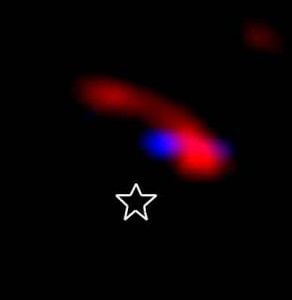A Planet Spotted As It Begins To Form
Scientists using the Keck telescope in Hawaii have found what may be a protoplanet, the youngest planet ever found
/https://tf-cmsv2-smithsonianmag-media.s3.amazonaws.com/filer/20111021093021teramuraV2_planet-disk_web.jpg)
Planets form from disks of swirling material that condense into solid bodies. Once only a theory, this formation has now been caught in the act by scientists using telescopes at the W.M. Keck Observatory in Hawaii (a site that should be familiar if you’ve read the Smithsonian story on black holes). The planet’s name is LkCa 15 b and researchers say it’s a protoplanet (below, in blue), still surrounded by cool dust and gas (in red). “We…found a planet, perhaps even a future solar system at its very beginning,” says the University of Hawaii’s Adam Kraus, lead author of the study that will appear soon in the Astrophysical Journal.

Kraus and his co-author, Michael Ireland of Australia’s Macquarie University, made their discovery by combining two techniques to cancel out the light from bright stars. The first is adaptive optics, which uses powerful computers to rapidly manipulate the telescope’s mirrors and adjust for distortions caused by Earth’s atmosphere. The second is aperture mask interferometry, and it further improves the resolution of the telescope. “We can manipulate the light and cancel out distortions,” Kraus says. They pointed the telescope at the star LkCa 15, canceled out the star’s light and there it was, a newly forming planet.
“LkCa 15 b is the youngest planet ever found,” Kraus says. “This young gas giant is being built out of the dust and gas….For the first time, we’ve been able to directly measure the planet itself as well as the dusty matter around it.”
Phil Plait, at Bad Astronomy, has more details:
The disk’s hole is about 8 billion km across. Disks like this are seen around other stars, and it’s generally thought that the hole is caused by a planet orbiting inside that region sweeping up material. In this case, that looks to be true! If the planet is in a circular orbit, it’s about 2.5 billion kilometers from its star, a little closer to its star than Uranus is from the Sun (it’s not known if the orbit is circular or elliptical; that’ll take a few years of observations as the planet physically moves around the star and the orbit can be calculated). The planet is much hotter than you might expect, but that’s because it’s so young: material is falling onto it, heating it up. That’s why it’s glowing in the infrared.
…Nothing like this has been seen before in a planet so young! That’s scientifically quite important. Our models of how planets form are complex, and we need detailed observations to see if the models are correct or not. Since planet formation is a process, we need observations of it at different stages, including very early on. That’s crucial, since it represents the transition period between the time before planets start to form in the disk, and the time when the planets are all finished and tidied up. We’ve seen both of those before, so this observation is a first.
Check out the entire collection of Surprising Science’s Pictures of the Week and get more science news from Smithsonian on our Facebook page.
/https://tf-cmsv2-smithsonianmag-media.s3.amazonaws.com/accounts/headshot/Sarah-Zielinski-240.jpg)
/https://tf-cmsv2-smithsonianmag-media.s3.amazonaws.com/accounts/headshot/Sarah-Zielinski-240.jpg)